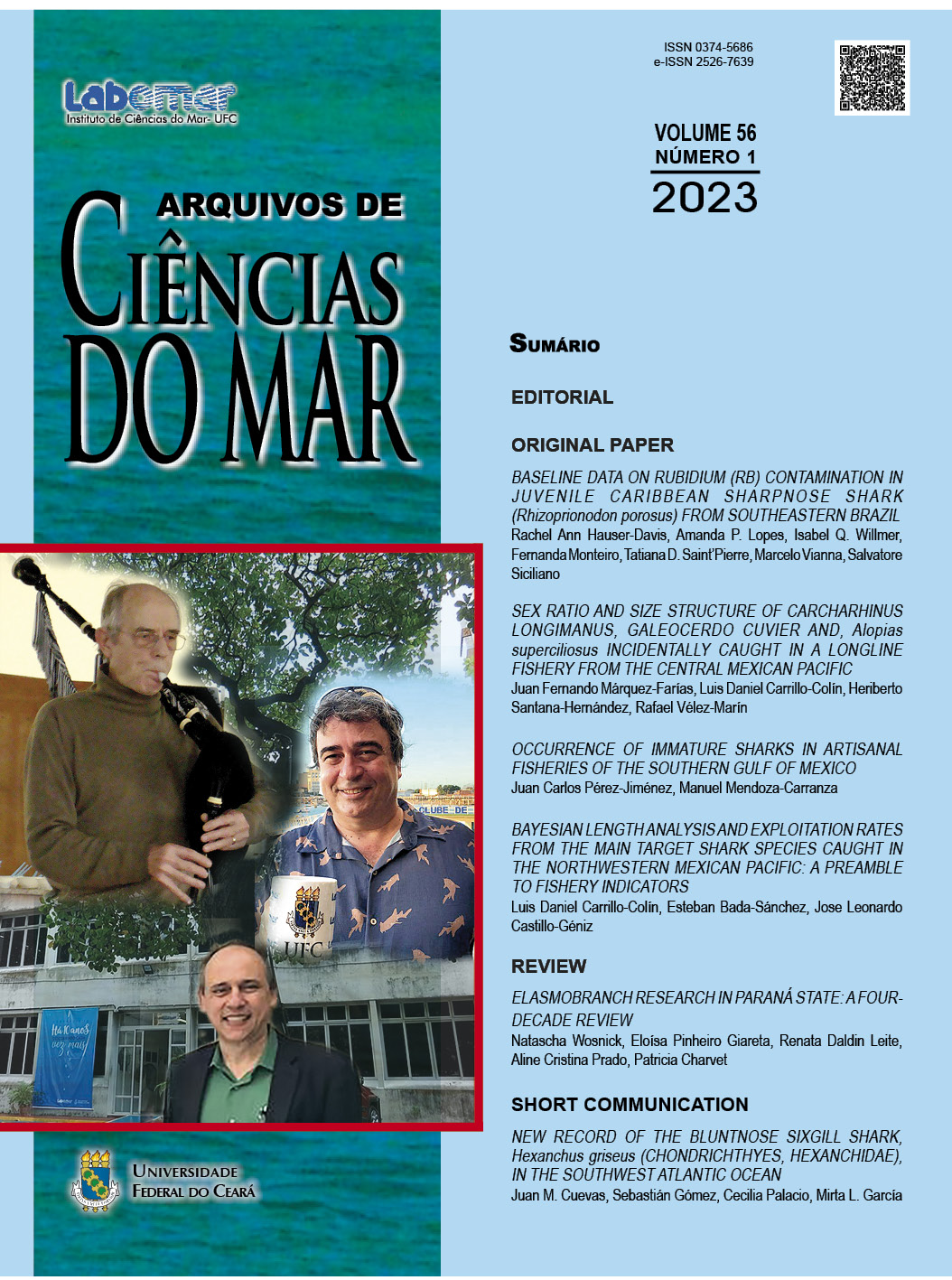TAXONOMIC IMPLICATIONS OF THE RESOURCE “BATOIDS” IN COMMERCIAL LANDINGS OF BOTTOM TRAWL FISHERIES IN SOUTHERN BRAZIL
Implicações taxonômicas do recurso “raia” nos desembarques da pesca comercial de arrasto de fundo no Sul do Brasil
DOI:
https://doi.org/10.32360/acmar.v56i1.92920Abstract
A survey conducted to study batoid species landed by the bottom trawl fishing fleet of Rio Grande, RS, Brazil, was carried out from 2001 to 2015. The objective of the study was to assess the diversity of batoids on the southern shelf of Brazil, a crucial area for the reproduction of this group. Understanding the taxonomic composition of this group is essential for conservation efforts. A total of 2,360 specimens were recorded, with 15 taxa identiϐied to species: Rioraja agassizii (n = 617; 26.1%), Sympterygia bonapartii (20.4%), Atlantoraja castelnaui (14.8%), Atlantoraja cyclophora (12.7%), Zapteryx brevirostris (11.8%), Sympterygia acuta (4.4%), Atlantoraja platana (1.9%), Dasyatis hypostigma (1.4%), Pseudobatos horkelii (0.6%), Myliobatis goodei (0.5%), Gymnura altavela (0.3%), Psammobatis extenta (0.2%), Psammobatis rutrum (0.2%), Psammobatis lentiginosa (0.1%), and Myliobatis freminvillei (0.04%). Among the batoids (‘raia’), there are several categories locally used by fishermen when separating the fish for processing in the industries. Skates (Rajiformes) are locally known as part of a generalized category called ‘emplastro’ by fishermen for commercialization. This category includes A. cyclophora, A. platana, R. agassizii, and juvenile A. castelnaui. However, it was observed that, within this fishing category, Myliobatiformes, especially smaller species, are often grouped together within ‘emplastro.’ Fishermen also classify ‘emplastro’ into ‘emplastro amarelo’ (yellow ‘emplastro’), corresponding to S. acuta and Myliobatiform pectoral fins, and ‘emplastro bicudo’ (long-beaked ‘emplastro’), which refers to S. acuta. The carcasses of A. castelnaui are processed separately and grouped as ‘emplastro pintado’, ‘raia pintada’, ‘raia marcela’, or ‘raia chita’. Rhinopristiformes are classified as ‘raia viola’ (Brazilian guitarfish), corresponding to P. horkelii, and ‘raia banjo’ (shortnose guitarfish), corresponding to Z. brevirostris. Females predominated (1,258; 53.3%) over males (n = 666, 28.2%), and a considerable number of immature individuals were recorded (n = 545; 23.1%). Pair trawling was the most commonly used method (82%) and was more likely to capture medium to large-sized species.
Keywords: Biodiversity, By-catch, Species conservation, Elasmobranch, Overfishing.
Downloads
Published
Issue
Section
License
Copyright (c) 2024 Arquivos de Ciências do Mar

This work is licensed under a Creative Commons Attribution 4.0 International License.
1. Proposta de Política para Periódicos de Acesso Livre
Autores que publicam nesta revista concordam com os seguintes termos:
- Autores mantém os direitos autorais e concedem à revista o direito de primeira publicação, com o trabalho simultaneamente licenciado sob a Licença Creative Commons Attribution que permite o compartilhamento do trabalho com reconhecimento da autoria e publicação inicial nesta revista.
- Autores têm autorização para assumir contratos adicionais separadamente, para distribuição não-exclusiva da versão do trabalho publicada nesta revista (ex.: publicar em repositório institucional ou como capítulo de livro), com reconhecimento de autoria e publicação inicial nesta revista.
- Autores têm permissão e são estimulados a publicar e distribuir seu trabalho online (ex.: em repositórios institucionais ou na sua página pessoal) a qualquer ponto antes ou durante o processo editorial, já que isso pode gerar alterações produtivas, bem como aumentar o impacto e a citação do trabalho publicado (Veja O Efeito do Acesso Livre).

